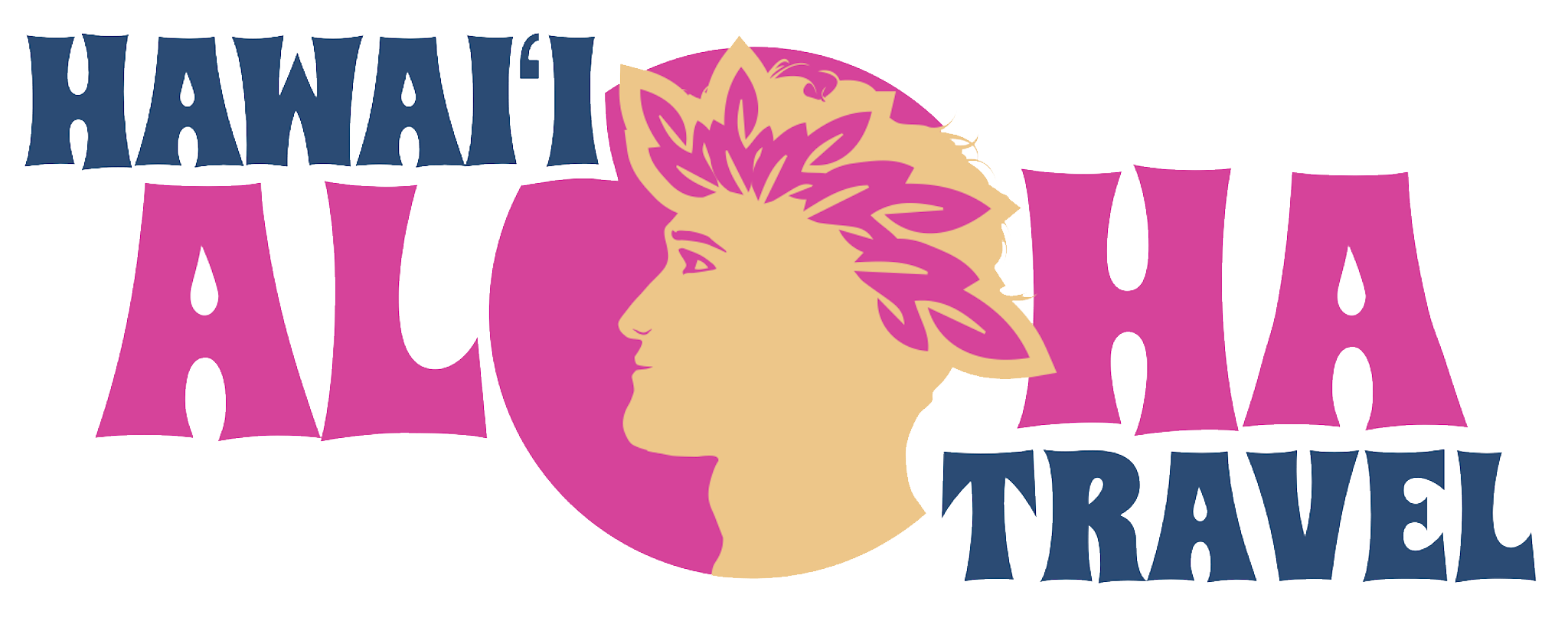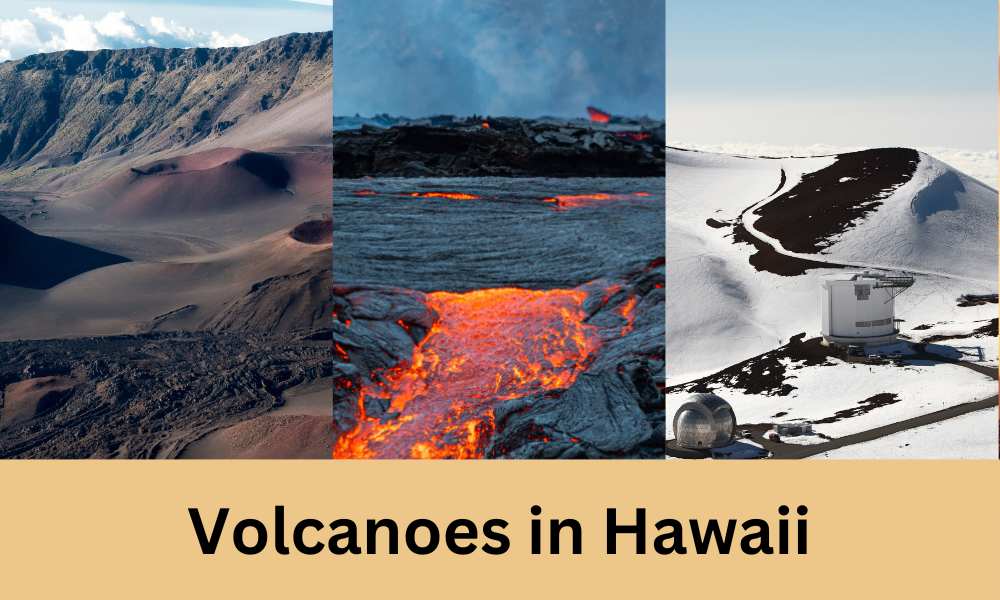People travel from all over to see the many famous volcanoes in Hawaii. Adventurers hike across the craters, sightseers marvel at the beauty, and curious souls study the many scientific wonders.
From the glowing lava of Kilauea to Kauai’s long-extinct cliffs, Hawaii is the place to go for anyone who wants to appreciate the magnitude of volcanoes. All of Hawaii was formed by volcanoes, and its famous landscapes and world-class beauty exist because of eruptions.
So let’s travel through history and across the islands to discover Hawaii volcanoes, famous and obscure, old and new.
Hawaiian Volcanoes: A Brief History

To appreciate the famous volcanoes in Hawaii, you first need to understand that all of Hawaii was formed by volcanoes. These eruptions began about 70 million years ago, and through the ages, the Hawaiian islands formed. Niihau is the oldest island, followed by Kauai, and they get younger and younger as you move east.
Hawaii Island is the “baby” of the islands, if you’re measuring by age. It’s a young one at just half a million years old (so young, right?!). But Hawaii Island is also the largest – and it’s continually growing! Since there are still active volcanoes on the island, lava is expanding its landmass over the years.
The islands formed long before humans arrived to Hawaii. It was around 1000 AD that Polynesians settled here. But volcanic eruptions continued, especially on Maui and Hawaii Island. And volcanoes became an integral part of Hawaiian legends and culture.
The Most Famous Volcanoes in Hawaii
If you want to see a volcano in Hawaii, you’ll want to go to Hawaii Island (AKA the Big Island or the Island of Hawaii). This is where you’ll find Hawaii Volcanoes National Park and two of the world’s most active volcanoes. And, if you time your trip right, you can see the active eruption of Kilauea.
Keep reading to learn more about Hawaii’s famous volcanoes and how you can see them.
Kilauea (Hawaii Island)

The youngest and most active volcano in Hawaii is Kilauea. This is the go-to destination for anyone wanting to see a volcanic eruption, since lava often oozes out of this geographical hotspot.
In fact, Kilauea erupted almost nonstop from 1983 to 2018. During that time, Halema‘uma‘u crater became a lava lake. Visitors came from around the world to see the lava glow, or to stand over a steam vent, or to marvel at the sights at the volcano’s summit.
Kilauea has continued to erupt off and on over the years. Even if it’s not erupting during your Hawaii vacation, it’s still worth the visit. There are vast volcanic landscapes that you can drive or walk through. Highlights include elevated overlooks, mesmerizing lava caves, and an array of wildlife that call the volcano home.
Mauna Loa (Hawaii Island)
Mauna Loa covers half of Hawaii Island and is the largest active volcano on Earth. It erupted most recently in 2022, and scientists are watching it closely, ready for another eruption soon.
Since recent lava flows have come close to highways and towns, a Mauna Loa eruption poses a threat to Hawaii Island.
Mauna Loa has many hiking trails, and a one-lane road takes you through some of the volcano’s most iconic sights. The Mauna Loa Scenic Drive is 17 miles long and is one of our favorite Hawaii road trips!
Mauna Kea (Hawaii Island)

The tallest point in Hawaii is the Mauna Kea Summit. Mauna Kea is a dormant volcano that last erupted 4,000 – 4,500 years ago. This volcano is famous for its stargazing. The best night sky views are from the visitors center, but if you want to get as high as possible, you can book a guided tour all the way to the summit.
Though Mauna Kea is dormant, it’s far from extinct. Scientists predict that Mauna Kea will erupt again, and estimate that it’s statistically due for an eruption every 1,000 years.
Fun Fact: If you measure from the ocean floor, Mauna Kea is the tallest mountain on Earth (33,500 feet). It’s more than a mile taller than Everest!
Haleakala (Maui)

Let’s travel to Maui, where you’ll find the towering mountain of Haleakala. This famous Hawaii volcano last erupted about 500 years ago, and it will likely erupt again.
This isn’t where you’ll go to see an active lava flow, but it is a popular destination for anyone visiting Maui. Haleakala National Park has incredible wildlife, hiking trails, vistas, and stargazing.
One of the most famous things to do on this Hawaii volcano is watching the sunrise. Be sure to make a reservation if you want to access the summit for sunrise viewing, or come at sunset for fewer crowds (and no early wake-up alarm!).
Other Hawaii Volcanoes
Four volcanoes tend to attract the most attention and visitors in Hawaii: Kilauea, Mauna Loa, Mauna Kea, and Haleakala. But they’re far from the only places where you can learn about volcanic activity on the islands.
Here are a few more volcanoes you should know about before your next Hawaii vacation.
Kamaʻehuakanaloa – Formerly Loihi (Hawaii Island)
Off the southeast coast of Hawaii Island, there’s a young, underwater volcano that could one day create a brand new island. Kamaʻehuakanaloa (formerly known as Loihi) last erupted in 1996. Its summit reaches about 3,000 feet below sea level, but within the next 200,000 years, it could reach the ocean’s surface, extending the Hawaiian island chain even further.
Hualalai (Hawaii Island)
You don’t hear as much about Hualalai, though it’s one of Hawaii’s most recently active volcanoes. Hualalai last erupted in 1801, and it likely will erupt again within the next 100 years. So, though Hualalai is a less famous Hawaii volcano, it still is a mighty force.
Why doesn’t Hualalai get as much attention? Maybe it’s because it seems to dwarf below its towering neighbors. Its elevation is 8,271 feet, while Mauna Kea and Mauna Loa reach over 13,000 feet high.
Or, maybe it’s because Hualalai is on private property. You have to book a guided hiking tour to access it. This could be costly for some Hawaii vacationers, but it does make the visit seem special. You’ll be one of the few walking upon its slopes and wandering at its majesty.
We recommend visiting Hualalai if you’re a frequent Hawaii visitor who has visited (and loved!) the other famous volcanoes in Hawaii. Hiking here will be a new experience in a new place. But, if it’s your first time visiting a Hawaii volcano, Kilauea or Mauna Loa may be more beginner-friendly.
Extinct Hawaii Volcanoes

There are no active or dormant volcanoes on Oahu or Kauai, but you can certainly see the remnants of ancient volcanic activity.
Two familiar names have their origins as volcanos: Waianae and Koolau. Yes, these two mountain ranges were once volcanoes. Hundreds of thousands of years ago, eruptions and erosions formed Oahu’s varied landscape.
Some of the best places to marvel at Oahu’s extinct volcanoes are its craters, like Diamond Head and Hanauma Bay.
You can also see evidence of ancient volcanoes on Kauai. Nearly 5 million years ago, Wai’ale’ale erupted and formed the island of Kauai. Today, you can witness its striking beauty and unique shape by taking a sailing tour of the Napali coast or hiking along Waimea Canyon.
Pele: The Famous Volcano Goddess of Hawaii

If you’ve ever studied Hawaii’s volcanoes, there’s one name you can’t avoid: Pele. The Hawaiian Volcano Deity is embodied by lava and often appears in legends with a fiery temper. But she destroys and creates, just as volcanoes have cleared the landscape of Hawaii and brought forth new shapes and growth.
As historians and scientists study volcanic activity in Hawaii, they often align the known eruptions with the oral stories of Pele.
FAQ About Hawaii’s Volcanoes

Is it safe to visit a volcano?
The National Park Service takes great steps to ensure safety while visiting the famous volcanoes in Hawaii. They’ll monitor seismic activity and eruptions and make closures out of an abundance of caution. You may see roads or hiking trails closed during your Hawaii vacation or notice rules that seem extreme. This is because volcanoes can be dangerous places, and not just because of eruptions.
Rough landscapes, slick or narrow roads, varying weather, and rugged paths can make volcanoes unsafe for visitors. These common safety risks are a much bigger threat than an eruption. So always use caution when driving or hiking through Hawaii’s volcanoes, and always obey the rules.
Should I worry about volcano eruptions during my Hawaii vacation?
No. Even if you’re vacationing near one of Hawaii’s active volcanoes, an eruption isn’t a general risk.
What’s the best volcano to visit in Hawaii?
Kilauea is the most popular volcano to visit in Hawaii. The views of the Halema‘uma‘u crater, along with the fantastic trails and driving routes, make it an unforgettable experience that highlights the power of volcanoes throughout the state.
What’s the best time of day to see a Volcano?
We recommend timing your visit so you’re at the volcano during both daylight and dark hours. This will allow you to see some of the most prominent sights, witness the sunset or sunrise, and get in some stargazing, too. And, if Halema‘uma‘u crater is filled with lava, you’ll be able to see its glow at nighttime.
Planning a Hawaii Volcano Vacation
Do you want to visit the Big Island of Hawaii and see some of its famous volcanoes? Hawaii Aloha Travel can help! Plan an entire vacation around volcano viewing, or island hop to spend the day at Volcanoes National Park.
Our team of local Hawaii travel agents can help with flights, accommodations, Bg Island activities, and itineraries so that you can simply look forward to your trip!




